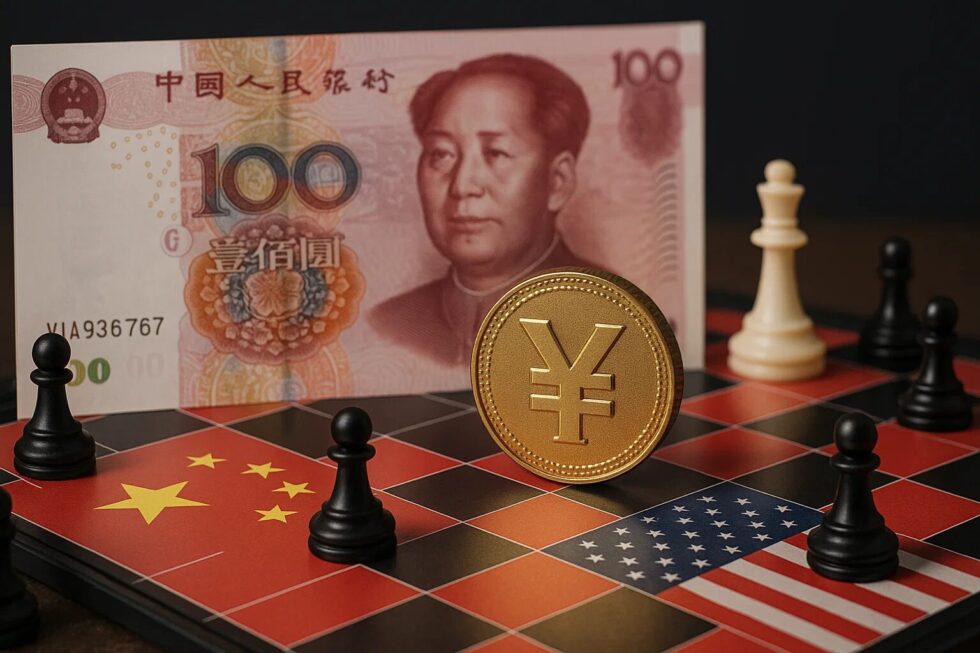Why could China’s yuan-backed stablecoins become a geopolitical game-changer for Germany

Yuan-backed stablecoins are quickly moving from theory to practice and could reshape the international financial system in ways that directly affect Germany. For Beijing, they are not just a new financial instrument, but a strategic tool to challenge the dominance of the US dollar and expand China’s influence in global trade. For Germany, which is both the economic engine of the EU and one of China’s largest European trade partners, these developments are particularly relevant. If yuan-backed stablecoins gain acceptance in Asia, Africa, and Latin America, German exporters and importers may have to adapt to a new reality of cross-border payments. At the same time, the European Central Bank and German regulators will face pressure to speed up the introduction of the digital euro in order to remain competitive. This digital shift could transform both Germany’s trade policy and its financial infrastructure, as noted by G.business.
Yuan stablecoins as an alternative to the US dollar
The main purpose of yuan-backed stablecoins is to offer a credible digital alternative to the US dollar in international trade. For China, this means breaking the reliance on dollar-based settlement systems, while for Germany it may mean recalibrating its financial and trade relationships. Germany is China’s biggest trading partner in Europe, with exports of cars, machinery, and chemicals worth over €100 billion annually. If German companies can settle contracts directly in yuan stablecoins, transaction costs could decrease, and foreign exchange risk could be reduced. Yet such a system also creates strategic dependencies, as Berlin would need to align trade practices with a currency heavily controlled by Beijing. In this sense, yuan stablecoins are not only a financial tool but also a political lever that China can use in negotiations with its partners.
Key aspects of yuan stablecoins:
- Lower transaction costs in German-Chinese trade.
- Hedging against dollar fluctuations for exporters.
- Independence from SWIFT in cross-border settlements.
- Direct oversight by the People’s Bank of China.
- Potential for large-scale adoption in the energy trade.
- Strategic influence over countries dependent on Chinese imports.
Geopolitical consequences for the global economy and Germany
The launch of yuan stablecoins will not just affect Asia or Africa but also Europe’s largest economy. Germany’s role as a manufacturing hub makes it vulnerable to shifts in global payment structures. If China pushes its partners in Africa or the Middle East to adopt yuan stablecoins for oil and gas payments, Germany may be forced to adapt in order to maintain supply chains. This would weaken the euro’s relative position and put pressure on the European Central Bank to accelerate its digital euro project. Moreover, if sanctions against Russia or other states can be circumvented using yuan stablecoins, Germany and the EU may find their sanction regimes less effective. This shift could deepen divisions within the EU between countries willing to embrace Chinese innovations and those aligned with US monetary dominance.
Regional consequences:
- Germany & EU – stronger competition with yuan-based trade systems.
- Africa – easier Chinese financing and infrastructure deals.
- Middle East – energy sales increasingly in yuan stablecoins.
- Latin America – gradual decline in dollar-based transactions.
- US – growing pressure to develop a digital dollar.
How the model of yuan stablecoins works
Unlike private cryptocurrencies, yuan-backed stablecoins will be fully controlled by Chinese state institutions. Each unit will be secured by yuan deposits in state-owned banks, ensuring that the token has real-world backing. For German companies, this creates both opportunities and challenges: transactions would be highly predictable but entirely subject to Chinese regulatory oversight. The system aims to combine blockchain transparency with centralized control, giving Beijing influence over every cross-border transaction. This model differs fundamentally from decentralized assets like Bitcoin or private stablecoins like USDT and USDC. It represents a new “hybrid” system where digital efficiency is combined with political oversight.
| Parameter | Yuan stablecoins | USDT / USDC | Bitcoin |
|---|---|---|---|
| Issuer | Chinese state banks | Private firms (Tether, Circle) | No issuer |
| Reserves | Yuan in state banks | USD deposits, bonds | None |
| Control | People’s Bank of China | Private audits | Decentralized |
| Use case | Global trade, energy | Crypto trading, DeFi | Digital gold |
Risks and challenges for Germany and the EU
While yuan stablecoins may simplify payments, they also pose major risks. For Germany, the biggest issue is dependency: settling in a currency controlled entirely by China could make German companies politically vulnerable. Another risk is sanctions – the US and EU could target institutions using yuan stablecoins, putting German banks in a difficult position. Furthermore, there are concerns about digital surveillance and data flows, as transactions would be transparent to Chinese regulators. In addition, the lack of clear EU regulations creates legal uncertainty, making German businesses hesitant to use these instruments even if they appear financially attractive. The challenge will be balancing economic pragmatism with political loyalty to the EU and transatlantic allies.
Main risks:
- Political dependence on China’s financial system.
- Possible US or EU sanctions on banks using yuan stablecoins.
- Legal uncertainty in European regulation.
- Cyber risks and potential system vulnerabilities.
- Decline of the euro’s global role.
What it means for German business and investors
For German companies, particularly in automotive, machinery, and chemical industries, yuan stablecoins could mean lower costs and faster payments. Exporters may be able to secure contracts in Asia with fewer exchange rate risks. Importers of Chinese goods could also benefit from smoother settlement processes. However, investors and banks must carefully assess the regulatory environment, as the EU may restrict the use of non-euro digital currencies. The Bundesbank has already emphasized that monetary stability is a core priority, and Germany will not risk undermining the euro’s credibility. Still, businesses may quietly explore yuan-based settlement if it proves practical and beneficial for trade.
Practical steps for German companies:
- Monitor ECB and BaFin regulations closely.
- Explore pilot projects with yuan settlements in Asia.
- Diversify currency reserves to hedge risks.
- Work with banks experienced in Sino-European trade.
- Assess the long-term viability of the digital euro.
Reactions from the US and EU
The United States is accelerating research into the digital dollar, while the European Central Bank is testing the digital euro. Both projects are designed to counter China’s influence and preserve monetary sovereignty. For Germany, this creates a dual challenge: aligning with EU monetary policy while also addressing the practical needs of companies trading heavily with China. The ECB’s pilot projects are already underway, focusing on retail payments and interbank settlements. Meanwhile, Washington is debating the political implications of introducing a central bank digital currency. Germany, as Europe’s largest economy, will play a decisive role in shaping how quickly the eurozone moves forward.
| Currency | Status in 2025 | Goals | Key risks |
|---|---|---|---|
| Yuan stablecoins | Pilots in Asia | Global trade, energy | Political control, sanctions |
| Digital dollar | Testing phase in US | Preserve USD dominance | Political divisions |
| Digital euro | ECB pilot projects | Strengthen euro, payment efficiency | Data privacy, bank disruption |
Which countries may adopt yuan stablecoins first
Not every country will immediately accept yuan stablecoins, but some are already signaling interest. Russia, Brazil, and Middle Eastern oil exporters are expected to be in the first wave. For Germany, this is highly relevant: if suppliers or energy exporters adopt yuan stablecoins, German companies may have no choice but to follow. Africa is another region where Chinese financing is strong, and yuan stablecoins could be quickly integrated. Latin America, particularly Argentina and Brazil, is also open to yuan-based settlements as part of BRICS cooperation. Germany will need to assess these developments carefully, especially as they affect supply chains and global energy security.

Likely first adopters:
- Russia – energy and defense trade.
- Brazil – agriculture and commodities.
- Saudi Arabia – oil sales to Asia.
- UAE – logistics and financial hub.
- Nigeria – Chinese loans and infrastructure.
- Argentina – financial crisis and need for liquidity.
Impact on the cryptocurrency market
Yuan stablecoins will also disrupt the crypto market, where USDT and USDC dominate today. If Chinese state-backed tokens become widely available, Asian exchanges may list them as trading pairs, reducing the dominance of dollar-backed assets. For Germany, this has implications for fintech and crypto startups, as well as regulatory policy. BaFin may have to decide whether yuan stablecoins are permissible in the German market, especially for institutional investors. At the same time, this development may accelerate work on a European crypto framework, ensuring that the euro retains relevance in the digital asset economy.
| Asset | Backing | Control | Use case | Growth potential |
|---|---|---|---|---|
| Yuan stablecoins | Yuan in state banks | People’s Bank of China | Trade, energy, crypto | High in Asia & Africa |
| USDT | USD deposits | Private audits | Exchanges, DeFi | Limited by US regulation |
| USDC | USD reserves (US banks) | US regulators | DeFi, payments | Strong in US & EU |
| Bitcoin | None, decentralized | No central authority | Digital gold | Global but volatile |
Yuan-backed stablecoins represent both an opportunity and a challenge for Germany. On the one hand, they could simplify trade with China and emerging markets, reduce transaction costs, and provide new tools for exporters. On the other hand, they raise questions about monetary sovereignty, political dependence, and regulatory risks. By 2030, it is likely that Germany will have to navigate a dual system: a digital euro within the EU and yuan stablecoins in global trade. The key question will be whether Berlin can balance its role as Europe’s financial leader with the realities of a multipolar digital economy.
Latest events in politics and global economy at Cryptonews – practical tips on how to act and invest. Read: What are the differences between CBDC and cryptocurrencies? Digital euro and its consequences explained